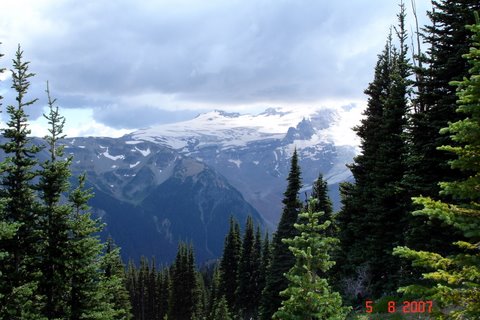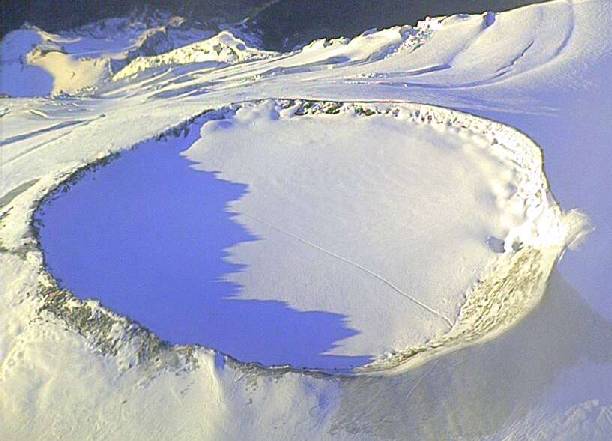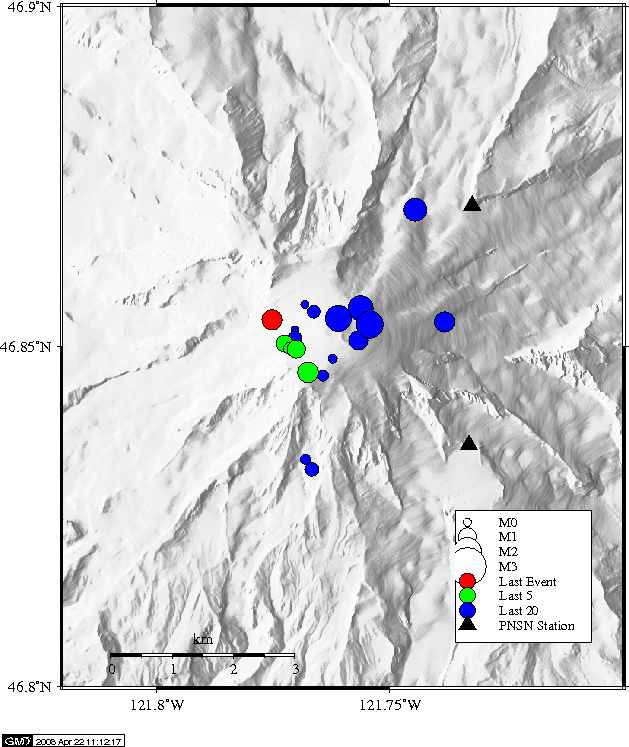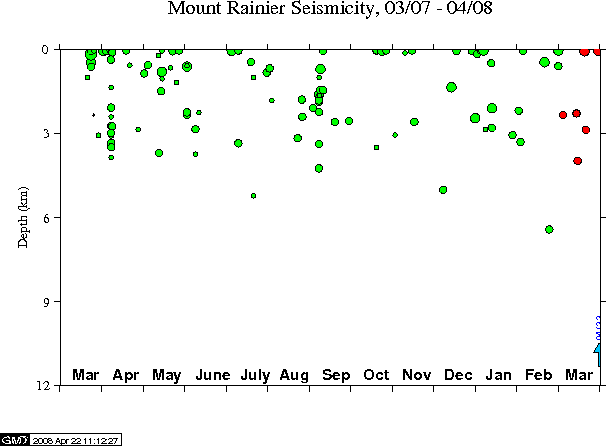|
Eruptive History and
Seismicity
and
Seismicity
Generally, Mt. Rainier's explosivity is
quite mild in comparison to many of the volcanoes in
this region. For example, Rainier's VEI, on average is
about a 3. In comparison the VEI for Mt. St. Helens in
1980 was a 5
VII.
Mt. Rainier experienced most of its large
eruptions before 300BC. However, the 1800s saw a busy
period with as many as 8 eruptions in the one century.
Therefore. there was a long period of repose from 300BC
to the 1800's and Rainier has not seen major activity
post 1800s
V.
Photo
by Amy Appleby
|
Date |
VEI |
Description |
|
1894 |
1 |
Explosive |
|
1825-1882 |
2 |
7 possible
explosive eruptions in this time although
uncertain. |
|
1500 |
N/A |
Possible period
for the Electron Mudflow—most likely not
triggered from an eruption |
|
300 BC |
4 |
Tephra volume: 1.2
x 108m3 |
|
Aprox. 520 BC |
? |
Explosive eruption
Pyroclastic Flows
Possible time of
the Round Pass Mudflow |
|
3400 BC |
3 |
Tephra Volume: 5
x 107 m3
Explosive Eruption |
|
3600 BC |
2 |
Tephra Volume: 1
x 106 m3
Explosive Eruption |
|
3650 BC |
3 |
Tephra Volume: 4.5
x 107 m3
Explosive Eruption
Mudflows (Osceola
Flow)
Debris Avalanches |
|
4400 BC |
2 |
Tephra Volume: 2.5
x 106 m3
Pyroclastic Flows
Mudflows |
|
4900 BC |
3 |
Tephra Volume: 5
x 107 m3
Explosive Eruption |
|
5300 BC |
3 |
Tephra Volume: > 5
x 106 m3
Explosive Eruption |
|
6800 BC |
3 |
Tephra Volume: >
2.5 x 107 m3
Explosive Eruption |
Sources:
V,
VI
Photo: 7

The
Crater at Mt. rainier, the shadow highlights the jagged
edges
As mentioned
above, during the 1800s there were many reported
eruptions, however, these may have been, "just
large dust clouds, caused by rock falls, that were
mistaken for clouds of newly erupted ash"
VI.
However, the most recent
eruption of Mt. Rainier was November 21st, 1894. There
is no physical evidence of an eruption during this time,
but there are many eye witness accounts that match the
behavior of a small ash cloud
VI.
Perhaps the fall out was so minute that it was quickly
dispersed and therefore hard to find a deposit for.

Current Seismicity
Rainer is unique in that it has the most
seismic activity out of all the volcanoes in the Cascade
region. Generally, it can have one or two high-frequency
volcano-tectonic earthquakes directly beneath the summit
per month . A study by Moran et al states that the
movement of gases has created pressure on the rock
causing them to become brittle and break. The
high-frequency 'quakes tend to be characteristic of the
'snapping' of rocks. Moran argues that the fluids have
found a way through the brittle rock "via a narrow
conduit" causing fumarolic activity while also
hydro-thermal altering the edifice
VIII.
Plots of most
recent (as of 04/24/08) seismic activity on Mt Rainier.
Most of the earthquakes are directly under the summit.Photo:
8
Additionally,
there is a study by Christiansen et al. that found that
in the cascade range, seismicity increases during the
summer months (about June-Dec). They account this to the
decrease of 'static stress change' from the melting of
snow and ice and also the 'ground water recharge'
increasing pore pressure. Therefore, during June-Dec it
is expected to see an increase in shallow earthquakes
under Rainier
XVI.

Graph of most
recent (as of 04/24/08) seismic activity based on depth.
Most of the earthquakes have been under 3km from the
surface, possibly close to the magma chamber.
Photo: 9.
If Mt Rainier does erupt, based on past
examples, there will probably be a small amount of fall
out relative to many other volcanoes in the region.
However, according to a study by Reid et al, due to
Rainier's hydro-thermal altering of the rock and steep
slope, there is likely to be a failure of the upper west
flank
IX. Therefore an eruption
could cause a debris landslide, which, mixed with the
snow and ice on the summit, could produce a massive and
devastating Lahar (see hazard Map section and 'The
Biggest Lahar in history').
|